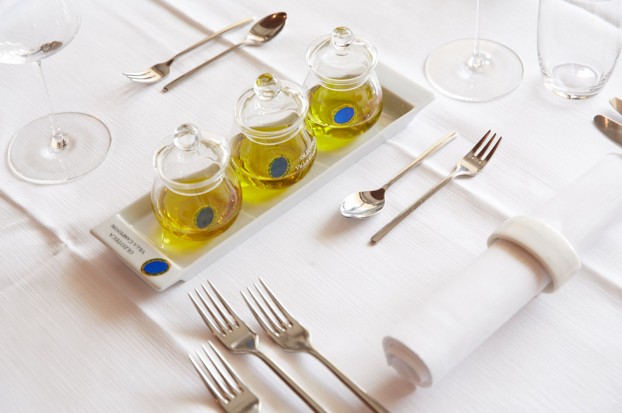
The superior quality olive oil: Oleoteca Villa Campestri
The extra-virgin olive oil is the oil obtained from the olive, only through mechanical procedures that do not involve the alteration of the oil. Discover the characteristics of a quality oil through a sensory journey to the Villa Campestri Oleoteca!
When the olive oil can be defined as superior quality?
Extra virgin olive oil is defined as the oil obtained from the first pressing of olives through mechanical processes, therefore without recourse to processes or chemical substances.
It is produced under conditions that do not cause alteration of the oil and whose free acidity, expressed in oleic acid, is not higher. 0.8%.
The fresh olives of first quality, picked and squeezed, do not undergo other treatment in addition to washing, separation from twigs and leaves, centrifugation and filtration.
With this production system the oil maintains both the lipid content and the “minor components”, in particular antioxidants, which are so important from a “nutraceutical” point of view. In all other types of oils, during the refining process, they are almost completely halved and lost.
The benefits of extra virgin olive oil
The benefits that extra virgin olive oil brings to health have been demonstrated in many scientific researches.
Despite being a caloric food (9kcal/g) it has been shown that the populations that consume 60g daily of olive oil gain enormous health benefits from this food.
Below we have reported some of the most important beneficial effects of extra virgin olive oil on health:
- Circulatory system: prevents arteriosclerosis, heart attack and renal failure;
- Skin: thanks to vitamin E it has an antioxidant action reducing the signs of aging;
- Digestive system: improves gastric, intestinal and hepatic function.
An experience at the Oleoteca of Villa Campestri
Villa Campestri is the first Olive Oil Resort in the world.
In the heart of Mugello, immersed in the beauty of this ancient Renaissance Villa, you can experience the absolute pleasure of immersing yourself in the extraordinary world of the oil of excellence.
Our oil comes from an ancient olive grove, from olives processed in the company’s oil mill and then savored in the prestigious ampoules during the tasting courses in our Oleoteca.
At the Villa Campestri’s Oleoteca you can experience a sensory journey that recovers the traces of an ancient culture, unfortunately nowadays largely lost all over the world.
Thanks to the passion and the studies of Paolo Pasquali, owner of the Olive Oil Resort, we will learn the technique of smelling, tasting, observing and exciting ourselves to discover the incredible taste notes of the oils of excellence.
We will learn the true meaning of the word “extra virgin” and how to describe it using correctly the terms “fruity”, “bitter” and “spicy”.
We will discover how to recognize a good oil from a defective one and how to correctly combine the Oils with your creations in the kitchen, transforming a common dish into something extraordinary.
A trip to Tuscany can not be called complete without a sensory experience that will allow you to savor, learn and taste the best extra virgin olive oils produced in this wonderful land. An experience that allows you to combine taste with ancient Tuscan traditions.
We are waiting for you at the Villa Campestri Oleoteca to experience this unmissable sensory experience in the way of extra virgin olive oil!
Quick Booking snippet
Tuscany, an Italian region renowned for its cultural and historical wealth, is home to numerous UNESCO World Heritage Sites. These sites represent not just the architectural and artistic beauty of the region but also its significant historical heritage.
Italian cuisine, celebrated globally, is a mosaic of flavors and traditions. From the rolling hills of Tuscany to the bustling streets of Naples, each region contributes its unique essence to what we recognize as Italian cuisine. This culinary journey explores how history, culture, and regional diversity have shaped the renowned gastronomy of Italy.
Tuscany is world-renowned for its rich winemaking tradition, a heritage rooted in centuries of history and culture. In this detailed guide, which is like a true oenological journey, we will discover not only the fine wines of the region but also the traditions and landscapes that make Tuscany an unmissable destination for wine lovers.
In the heart of Italy, Tuscany stands out as one of the most emblematic regions for wine production. Famous for its landscape of gentle hills, cypress trees, and picturesque villages, this region is also a paradise for wine lovers. Tuscan vineyards, nourished by fertile soil and an ideal climate, produce wines that are appreciated worldwide […]
For those looking for a firsthand experience, the Agricultural Tourism Company Badia di Susinana offers horseback rides and trekking and riding courses with a guide, in addition to hospitality for horses and riders, located in Palazzuolo sul Senio. Alternatively, the Farm I Cavalli del Vento allows crossing beech forests and vast chestnut groves, with rides […]
Sport fishing in Tuscany offers a wide range of opportunities due to the abundance of inland and coastal waters in the region. Specifically, the province of Pistoia, with Lake Nievole in Serravalle Pistoiese, is renowned for trout fishing and other fish such as carp, grass carp, tench, and sturgeon, with a catch and release rule. […]
In Val di Chiana, to savor an authentic Chianina steak, there are several renowned restaurant options: 1. Ristorante Casa Cecco: Offers the chance to taste a Chianina steak in a farmhouse dating back to 1600. 2. Agriturismo di Trequanda: Here, Chianina meat, raised in local pastures and processed by the company’s trusted butcher shop, becomes […]
The Italian Quattrocento was a period of extraordinary artistic effervescence that produced numerous world-renowned artists. Among them, some of the most influential were: 1. Andrea Mantegna (1431–1506): A painter and engraver from Padua, famous for his frescoes in the Camera degli Sposi in Mantua.

